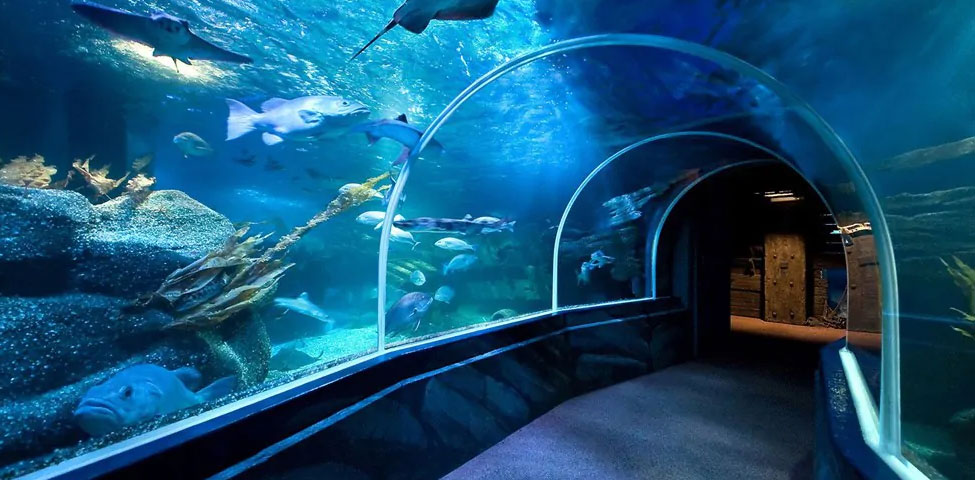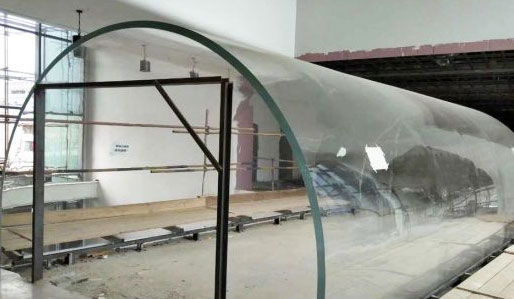Home » Blog » Arch Glass for Room-Size Aquariums: A Comprehensive Guide
Posted on : 30-04-2024 Author : Meghna Sen

Creating a room-size aquarium with arch glass involves careful consideration of design, manufacturing, and installation processes. The use of high-quality, curved glass enhances the aesthetic appeal and structural integrity of the aquarium, providing a breathtaking underwater experience. With proper planning and execution, arch glass aquariums can transform any space into a captivating marine haven, blending beauty with functionality. These aquariums leverage the beauty and structural benefits of curved glass, making them a centerpiece in various settings, from private residences to public spaces. This guide explores the types of glass suitable for arch aquariums, the importance of waterproof sealing, and the considerations regarding water pressure on the glass.

Design and Benefits:
Aesthetic Appeal:
- Panoramic View: Arch glass provides a seamless, panoramic view of the aquatic environment, enhancing the viewer's experience.
- Modern Design: The curved shape adds a sleek, contemporary look, making the aquarium a focal point in any space.
Structural Integrity:
- Load Distribution: The arch shape helps distribute the weight of the water evenly, reducing stress on any single point and enhancing the overall strength.
- Enhanced Strength: Curved glass inherently possesses better strength characteristics than flat glass of the same thickness, making it more resistant to pressure and impacts.
Types of Glass to be Used
Tempered Glass:
- Strength and Safety: Tempered glass is up to five times stronger than regular glass. It is designed to crumble into small, blunt pieces if broken, reducing the risk of injury.
- Thermal Resistance: This glass can withstand higher temperatures and sudden temperature changes, making it suitable for aquariums.
Laminated Glass:
- Safety and Security: Laminated glass consists of two or more layers of glass bonded with a plastic interlayer. Even if it breaks, the interlayer holds the fragments together, enhancing safety.
- Durability: It offers excellent durability and can withstand significant pressure and impacts.
Acrylic (Optional):
- Weight and Flexibility: Acrylic is lighter than glass and can be formed into complex shapes more easily. However, it is more prone to scratching and may require more maintenance.
- Clarity and Strength: Acrylic provides excellent clarity and strength but is generally used in conjunction with glass or as a standalone material in some designs.
Waterproof Sealing
High-Quality Seals:
- Silicone Sealant: Aquarium-grade silicone is commonly used for sealing joints and edges. It is flexible, durable, and resistant to water and UV rays.
- Polyurethane Sealant: This type of sealant provides strong adhesion and flexibility, making it suitable for larger aquariums where structural movement might occur.
Application Process:
- Clean Surfaces: Ensure all glass surfaces are clean and dry before applying the sealant to ensure proper adhesion.
- Consistent Bead: Apply a consistent bead of sealant along all joints, ensuring complete coverage without gaps or bubbles.
- Curing Time: Allow adequate curing time as recommended by the sealant manufacturer before filling the aquarium with water.
Inspection and Maintenance:
- Regular Checks: Inspect the seals regularly for any signs of wear, damage, or degradation.
- Maintenance: Replace or repair seals as needed to maintain the integrity of the aquarium and prevent leaks.
Calculating Water Pressure:
- Hydrostatic Pressure: Water pressure increases with depth, exerting more force on the lower parts of the aquarium. The pressure (P) at a given depth (h) can be calculated using the formula: P = ρgh, where ρ is the density of water, g is the acceleration due to gravity, and h is the height of the water column.
- Considerations for Large Aquariums: For room-size aquariums, this pressure can be substantial, necessitating thicker glass to withstand the forces involved.
Glass Thickness:
- Thickness Guidelines: The thickness of the glass should be chosen based on the height and volume of the aquarium. Generally, thicker glass (19mm to 38mm or more) is required for larger aquariums to safely withstand the pressure.
-Safety Margins: Incorporate safety margins into the design to account for additional stresses and potential impacts.
Stress Distribution:
- Curved Glass Advantages: The arch shape helps distribute stress more evenly across the surface, reducing the likelihood of failure at any single point.
- Support Structure: Ensure the supporting framework and mounts are designed to handle the loads without deforming or causing additional stress on the glass.